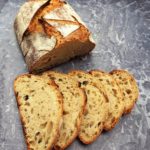
No-knead sourdough bread cooked in a cast iron pot
Ingredients
- 600 grams bread flour
- 2 tsp salt
- 60 g/ml sourdough starter (see Recipe Notes)
- 400 ml water (see Recipe Notes)
Instructions
The night before you want to bake the bread:
-
Put the flour in a large bowl and stir in the salt.
-
Dissolve the starter in the water.
-
Stir the liquid mix into the flour until you have a rough dough that leaves the sides of the bowl clean.
-
Cover the bowl and leave overnight or 12-16 hours.
On the day of baking:
-
Scrape the dough out of its bowl onto a floured worktop. If liked, stretch the dough by flattening then folding into thirds a few times to increase holes in finished loaf, otherwise simply shape to the proving vessel by folding. Cover and leave to rest on the worktop for 10 min.
-
Place the dough into a floured proving basket or tea towel-lined bowl, cover and leave for 60-90 min until a finger pressed into the dough slowly springs back rather than almost immediately.
-
Meanwhile, preheat the oven to its highest setting and put a cast iron pot with lid inside.
-
When ready, carefully flip the dough into the pot.
Slash the top, replace the lid and put into the oven.
Turn the heat down to 240C/220 C Fan / Gas 9 and bake for 30 min.
-
After 30 min, remove the pot, take the bread out and put the loaf directly on the oven shelf. Bake for 10-20 min more until the bread is cooked through, turning down the oven if necessary to stop outside burning.
-
Leave on a wire rack to cool.
Recipe Notes
Amount of starter. I use a relatively small amount of mature starter which works well for me. You can from 60 to 100 grams if preferred, but should reduce the flour in the recipe by 50 grams and the water by approximately 50 grams.
Amount of water. Different flours will absorb varying amounts of liquid so you may need to increase or decrease the water. The dough should be we but not sloppy.